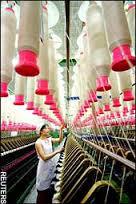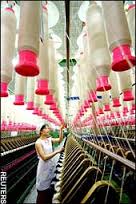Clothes Imported to EU the Primary Target

Exporters of textiles and fabrics to Europe now would have to go through stricter norms to be able to continue with exporting. The existing ban on use of chemicals for textiles now include nonylphenol ethoxylates (NPE) after the member states of the EU voted in favor of extending the chemical ban.
Nonylphenol ethoxylates (NPE) is a chemical substance that is widely found in the found in clothing and has been banned as it poses an “unacceptable risk” to the environment. Nonylphenol ethoxylates (NPE) had been banned in the EU region ten years ago but its finds its way into the region through imported textiles and clothes from non EU countries.
Nonylphenol ethoxylates (NPE) is toxic in nature for aquatic creatures like fish and the chemical finds its way into the aquatic environment from washing of clothes.
The scientists at the European Chemicals Agency (ECHA) ratified the harmful nature of the chemical after a proposal to banthe chemical form being imported was brought forward by Sweden in 2013.
The chemical disrupts the hormones of fish, affecting negatively their fertility, growth and sexual development since the chemical, after mixing in the water collects in the bodies of fish.
The chemical is used in the cloth manufacturing process as an agent to clean and rinse. The draft proposal that was presented at the EU quoted studies that had found NPE to exist in clothes that were being imported in the EU from non EU countries.
In 2011, two thirds of the clothes that were tested belonging to big and global brands like Adidas, H&M, Lacoste, and Ralph Lauren were found to contain traces of the chemical. The study by Greenpeace had stated that though the presence of this chemical was little, the solubility of the chemical in the environment posed a risk.
The new ban does not permit any clothes to be imported that have a presence of the chemical greater than 0.01 percent. The ban would come into force five years from now to allow the companies to source other alternatives to the chemical. The EU is likely to adopt the proposal in about a month or so.
The clothing companies on the other hand have come out strongly against the ban. In a comment letter on the issues sent to the ECHA, the clothing and textile companies claimed that it would be very difficult to eliminate NPE form the cloth and textile manufacturing process. The companies claimed that the chemical could not be easily replaced in the supply chain and has a number of uses and it would be difficult to find a similar chemical re reagent that could have the same effect on the manufacturing process.
The ban would be applicable to new cloth only and not for recycled ot used clothes as it is scientifically assumed that such clothes would have been washed several times and would have negligible residue of the chemical.
A study conducted by the UK environment agency in 2011 found that the 29% of imported cotton underwear contained NPE, most of which was released during the first two washes by the consumer. This was a cause of worry for the environmentalist at the EU. A Danish environment agency study confirmed that nonylphenol ethoxylates did not pose any threat to humans and that brightly colored and Chinese clothing contained the highest concentrations of NPE.
(Source: www.theguardian.com)
Nonylphenol ethoxylates (NPE) is a chemical substance that is widely found in the found in clothing and has been banned as it poses an “unacceptable risk” to the environment. Nonylphenol ethoxylates (NPE) had been banned in the EU region ten years ago but its finds its way into the region through imported textiles and clothes from non EU countries.
Nonylphenol ethoxylates (NPE) is toxic in nature for aquatic creatures like fish and the chemical finds its way into the aquatic environment from washing of clothes.
The scientists at the European Chemicals Agency (ECHA) ratified the harmful nature of the chemical after a proposal to banthe chemical form being imported was brought forward by Sweden in 2013.
The chemical disrupts the hormones of fish, affecting negatively their fertility, growth and sexual development since the chemical, after mixing in the water collects in the bodies of fish.
The chemical is used in the cloth manufacturing process as an agent to clean and rinse. The draft proposal that was presented at the EU quoted studies that had found NPE to exist in clothes that were being imported in the EU from non EU countries.
In 2011, two thirds of the clothes that were tested belonging to big and global brands like Adidas, H&M, Lacoste, and Ralph Lauren were found to contain traces of the chemical. The study by Greenpeace had stated that though the presence of this chemical was little, the solubility of the chemical in the environment posed a risk.
The new ban does not permit any clothes to be imported that have a presence of the chemical greater than 0.01 percent. The ban would come into force five years from now to allow the companies to source other alternatives to the chemical. The EU is likely to adopt the proposal in about a month or so.
The clothing companies on the other hand have come out strongly against the ban. In a comment letter on the issues sent to the ECHA, the clothing and textile companies claimed that it would be very difficult to eliminate NPE form the cloth and textile manufacturing process. The companies claimed that the chemical could not be easily replaced in the supply chain and has a number of uses and it would be difficult to find a similar chemical re reagent that could have the same effect on the manufacturing process.
The ban would be applicable to new cloth only and not for recycled ot used clothes as it is scientifically assumed that such clothes would have been washed several times and would have negligible residue of the chemical.
A study conducted by the UK environment agency in 2011 found that the 29% of imported cotton underwear contained NPE, most of which was released during the first two washes by the consumer. This was a cause of worry for the environmentalist at the EU. A Danish environment agency study confirmed that nonylphenol ethoxylates did not pose any threat to humans and that brightly colored and Chinese clothing contained the highest concentrations of NPE.
(Source: www.theguardian.com)





